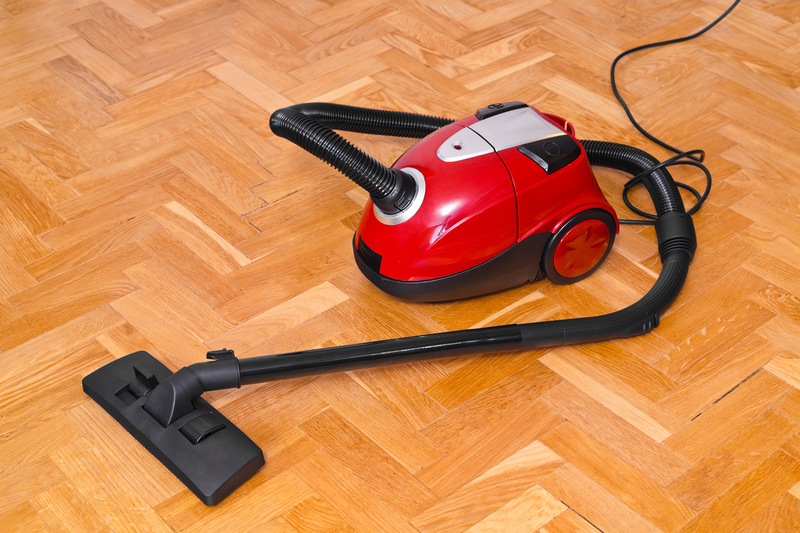Erase Grease: Your Handy Guide to Pristine Enamel Oven Trays
Posted on 22/09/2025
Erase Grease: Your Handy Guide to Pristine Enamel Oven Trays
Are greased-stained, grimy enamel trays turning your kitchen dreams into a cleaning nightmare? Banish the buildup for good. Cooking, baking, and roasting in the oven inevitably lead to one dilemma for every home cook: the enamel oven tray caked with stubborn, burnt-on grease. If you've struggled with scrubbing endlessly or wondered if your trays will ever look like new again, this comprehensive cleaning guide is your blueprint for effortlessly pristine oven trays. Read on and discover the secrets to erase grease, restore shine, and keep your kitchen sparkling.

Why Keeping Enamel Oven Trays Clean Matters
Not only does a clean enamel oven tray make your kitchen look and feel more inviting, but routine maintenance also benefits:
- Food hygiene - Old grease can harbor germs and taint the flavors of your next meal.
- Appliance longevity - Grease buildup can scorch or damage enamel surfaces and even affect oven performance.
- Ease of use - Clean trays are non-stick, reducing the effort for each subsequent cleanup.
- Fire risk reduction - Grease and burnt food particles can become fire hazards if not removed regularly.
Clean trays cook better and keep your kitchen safer.
The Science: Why Is Grease So Hard to Clean?
Grease is tricky by nature. When subjected to high oven temperatures, fats and oils oxidize, harden, and fuse onto the enamel surface. Without the right techniques, your regular dish soap and scrubby sponge simply can't break through that tough shield. That's why using focused, proven techniques for removing grease from oven trays is your best bet for sparkling results--and less elbow grease.
Preparation: Setting Up for Grease Removal Success
Before diving into cleaning, a little prep work ensures you protect both the tray and yourself:
- Let the Tray Cool: Wait until the tray is completely cool before starting.
- Protect Your Hands: Use gloves for comfort and protection from cleaning agents.
- Remove Loose Debris: Wipe or brush away loose crumbs and flakes before tackling stubborn residue.
- Select a Cleaning Zone: Work in a well-ventilated area, ideally near a sink with plenty of space.
The Best Methods to Erase Grease from Enamel Oven Trays
No two messes are exactly alike! Choose a technique (or combine a few) based on the severity of your tray's grease situation.
1. Soaking: The Classic First Step
Soaking enamel trays softens grease, making it easier to lift. Here's how:
- Fill your sink with hot water and a squirt of dishwashing liquid. For extra cleaning power, mix in a tablespoon of baking soda.
- Submerge the tray and leave it for at least 30 minutes, or overnight for heavy buildup.
- Wipe and rinse: Use a soft sponge or non-abrasive brush to gently remove softened residue.
Pro Tip: For super tough stains, re-soak and repeat as often as needed.
2. Baking Soda and Vinegar Magic (Natural Solution)
This dynamic duo is a staple for grease removal from enamel oven trays without harsh chemicals.
- Sprinkle baking soda generously over the greasy areas.
- Spritz with white vinegar. Watch as the mixture fizzes and works to lift away grease.
- Allow to sit for 10-20 minutes to give the acids time to break down hardened stains.
- Scrub gently using a soft brush or sponge, then rinse thoroughly.
Repeat if needed until your oven tray is sparkling clean.
3. Commercial Oven Cleaners: Fast-Acting but Cautious
For deeply ingrained grease, a heavy-duty oven tray cleaner can save time. However, many such products are caustic, so always:
- Read manufacturer instructions for your tray and the product.
- Avoid metal scouring pads which can scratch and dull the enamel finish.
- Ventilate well, and wear gloves to protect your skin.
Apply the cleaner, allow it to break down the grease, and rinse thoroughly before using the tray again.
4. Steam Cleaning (The Effortless Option)
If your oven has a steam clean or self-clean function, use it! Alternatively, create your own mini steam bath:
- Fill a roasting pan with water and place it on a lower oven rack with the enamel tray above.
- Turn on the oven to 180?C (350?F) for 20-30 minutes.
- Turn off and allow to cool; the steam will help loosen greasy particles making them easier to wipe away.
This is a gentle technique for cleaning enamel oven trays without scrubbing.
5. Lemon Power (Eco-Friendly Freshness)
- Cut a lemon in half and squeeze its juice over stuck-on grease.
- Let it sit for 10-15 minutes; the citric acid works wonders for breaking down grime.
- Scrub gently and wipe clean for both shine and a pleasant aroma.
How to Tackle Burnt-On Blackened Grease
Sometimes, repeated cooking leaves burnt black grease stains that seem impossible to remove. Here's a step-by-step for those extreme cases:
- Layer with paste: Mix baking soda and water into a thick paste. Apply generously over the worst stains.
- Cover: Lay damp paper towels over the paste to keep it from drying out.
- Leave overnight: This gives the mixture time to penetrate and loosen burned residue.
- Scrape and scrub gently: Use a plastic scraper (never metal!) to lift residue, followed by a gentle washing.
Don't be discouraged; several applications may be needed. Each effort lifts another layer of grime!
Enamel Oven Tray Cleaning FAQs
Can I put enamel oven trays in the dishwasher?
Yes, most modern enamel trays are dishwasher safe. However, dishwashers may not always remove baked-on grease. Pre-soak for best results, and place trays on the bottom rack for the most effective wash.
Are abrasive scouring pads safe to use?
Never use metal scouring pads or harsh abrasives on enamel. They scratch the smooth surface and can cause future stains to embed even more easily. Stick with soft sponges, plastic scrapers, or specialty enamel-safe pads.
Is it okay to use bleach or ammonia?
While bleach can sanitize, it's too harsh for enamel surfaces and can cause discoloration over time, especially with colored enamel. Stick to gentler, proven cleaners for best results.
How often should I clean my enamel oven trays?
Ideally, wipe them down after each use to prevent accumulation of grease. Schedule a deep cleaning at least once a month if using your oven frequently.
Prolonging the Pristine: Tips for Maintaining Enamel Oven Trays
Once you've restored your tray to its former shine, follow these tips to keep it looking (and smelling) its best:
- Wipe Spills Immediately: Don't let fats and oils sit--clean them up as soon as the tray cools.
- Line Trays for Baking: Use reusable silicone mats, parchment paper, or foil to minimize food contact with the enamel--and ease your next cleanup!
- Avoid Sudden Temperature Shifts: Rapid changes can crack enamel. Let trays cool naturally before washing.
- Dry Thoroughly: After cleaning, dry with a soft towel to prevent mineral spots or rust on any exposed metal edges.
- Inspect for Chips: Do not use trays with damaged enamel, as exposed metal can rust and contaminate food.
Choosing the Right Cleaning Tools and Products
Your toolkit for grease removal from oven trays doesn't require high-tech gadgets. Here's what works best:
- Soft non-abrasive sponges or microfiber cloths
- Plastic scrapers for loosening stubborn spots
- Baking soda, white vinegar, and lemons for natural cleaning power
- Enamel-safe commercial cleaners (optional)
- Dishwashing gloves for comfort and protection
Troubleshooting: When Grease Won't Budge
If persistent stains linger despite your best efforts, consider these advanced options:
- Repeated application: Sometimes, multiple rounds of your chosen method are needed. Be patient!
- Enzyme-based cleaners: These are designed to target organic stains like fats and proteins. Check your local store for eco-friendly enzyme cleaners suitable for kitchens.
- Baking soda paste & aluminum foil: Gently rub a paste of baking soda using a *ball of foil* as a "scrubber"--just make sure the enamel is not scratched or sensitive.
Green Cleaning: Eco-Friendly Grease Solutions
Natural cleaners such as baking soda, vinegar, and lemon not only get the job done but also protect your health and the planet. If you're looking for other green alternatives, try:
- Castile soap - A plant-based, biodegradable option for dishwashing.
- Essential oil boosters - Add a few drops of lemon or tea tree essential oil for antiseptic power and a fresh scent.
Eco-conscious cleaning is better for your tray, your household, and the environment.
Restoring the Gloss: Finishing Touches for Enamel Oven Trays
If your tray looks a bit dull after deep cleaning, restore its shine with this simple move:
- Mix a solution of equal parts white vinegar and water.
- Wipe down the tray with a soft cloth. Buff dry to finish.
This refreshes the surface and leaves your enamel oven tray looking as good as new.

Common Mistakes to Avoid When Cleaning Enamel Oven Trays
- Using sharp tools or knives to scrape off grease
- Saturating the tray in strong bleach or harsh chemicals
- Putting a very hot tray into cold water --this can crack the enamel
- Allowing baked-on grease to build up for too long, making cleaning exponentially harder
Conclusion: Your Roadmap to Effortless, Grease-Free Enamel Trays
Don't let greasy, stained oven trays cast a shadow over your culinary creations. Armed with these expert-approved methods, home remedies, and smart prevention tips, conquering grease is no longer a chore. Erase grease for good, and let your enamel oven trays shine, bake, and roast for years to come. Remember: consistent cleaning is the key to pristine trays and a hassle-free kitchen experience.
Ready to enjoy your next delicious meal without the dread of post-cooking clean-up? Try these strategies today and reclaim your kitchen's sparkle!
Stay Grease-Free, Stay Happy!
For more household cleaning hacks, smart kitchen organization ideas, and time-saving tips, bookmark this guide and never let grease build-up hold you back again.



